The Jamek Mosque - The then largest Mosque in Kuala Lumpur
 |
| The Jamek Mosque (now known as the Sultan Abdul Samad Jamek Mosque) |
Standing on the Market Street bridge (Market Street is now known as Lebuh Pasar Besar), the bridge that spans the Klang River, one can enjoy a good view of the confluence of the Gombak River and the Klang River where Kuala Lumpur began as a mining settlement. It was at this very site where adventurers and miners in the late 19th century would land and unload their provisions and equipments. At the confluence, on a triangular piece of land, stands a 108-year-old mosque, the Jamek Mosque of Kuala Lumpur. The mosque is now dwarfed by the neighbouring modern skyscrapers and the adjacent LRT Train Station as it is situated at one of the busiest spots of the city but it still retains its charm, grace and elegance.
The Jamek Mosque is not the first mosque built in Kuala Lumpur. Before the construction of the Jamek Mosque, there were already two earlier mosques known to have existed in Kuala Lumpur.
One of the mosques was known as Masjid Kampung Rawa or sometimes referred to as Java Street Mosque, completed in 1881, was probably just a simple wooden building. It was seated at the corner of Java Street (later renamed Mountbatten Road and now Jalan Tun Perak) and Ampang Street (now Lebuh Ampang). The mosque was still there until as late as 1903 despite being very much in need of repair and widening. The site of the mosque is where The Gian Singh Building now stands.
Another earlier mosque of Kuala Lumpur ever recorded is what the Indian Mosque (Masjid India) now is. The Indian Mosque that exists now originated from the Kampung Melaka Mosque said to have been built around 1859 by Encik Baki, the father-in-law of Haji Abdullah Hukom, possibly the earliest mosque in Kuala Lumpur. Over time the mosque started being patronised by Indian Muslims who migrated from India and stayed around the area. The mosque later became known variously as Masjid Keling, Masjid Chulia and Masjid India Selatan. That mosque was the precursor of the current Indian Mosque rebuilt in brick with Indo-Saracenic style in 1965.
In one of the earliest official maps of Kuala Lumpur produced in 1889 drawn by W.T. Wood, both earliest mosques of Kuala Lumpur were shown in the map. The top one in the map is the current Indian Mosque located on Dickson Street (now Jalan Masjid India) while the bottom one is the Kampung Rawa Mosque. Please also note the triangular piece of land that would be occupied by the Jamek Mosque later was labelled as the Malay Cemetery.
THE CONSTRUCTION OF A NEW MOSQUE.
The triangular piece of land between the junction of the Gombak and Klang Rivers, where the Jamek Mosque is now located, was the original Muslim burial ground but by 1891 it was cleared and fenced. Prior to this it was reported that the Sanitary Board on 11 September 1890 had invited its Muslim members to select a site, on the Ampang Road, for a new cemetery which still exists until today. It is believed the old burial ground has fallen into disuse even before 1890.
Despite being cleared and fenced since 1891, only seventeen years later the triangular piece of land was chosen as the site of a larger and more impressive mosque which J.M. Gullick in his book "A history of Kuala Lumpur: 1856-1939" regarded the mosque as another example of bridging cross-cultural boundaries. For the construction of this mosque the Malay Muslims and other Muslim residents managed to subscribe $12,000 while the Selangor Government was reported to have contributed $20,000.
Having raised the required fund the design of the mosque was entrusted to the government architect, A.B. Hubback. Hubback was the prolific government architect instrumental in designing various public buildings not only in Kuala Lumpur but also in Penang, Ipoh and Seremban. The Jamek Mosque was the fifth public building in Kuala Lumpur designed by him.
The Straits Times dated 25 March 1908 reported that the foundation stone of the new Kuala Lumpur Mosque was laid, on Monday afternoon (23 March 1908), by His Highness the Sultan of Selangor, Sultan Alaeddin Sulaiman Shah (11 Sept 1863 - 31 March 1938), in the presence of a large gathering which included Mr. H.C. Belfield, British Resident, the Raja Muda and the ex-Sultan Abdullah of Perak.
The laying of the foundation stone by the Sultan of Selangor inaugurated the construction of the Jamek Mosque of Kuala Lumpur which was at that time the largest mosque in Kuala Lumpur and the first one that featured impressive design. In fact, J.M. Gullick wrote in his "A history of Kuala Lumpur 1857-1939" book that it was regarded as one of Hubback's most successful designs, modelled after Mughal mosques of north India, rather than the more ponderous 'neo-saracenic' public buildings nearby.
More than one year later, on 23 December 1909, His Highness the Sultan of Selangor, Sultan Alaeddin Sulaiman Shah, came again to Kuala Lumpur to officially open the Jamek Mosque in a grand ceremony held by the British Selangor Government. The event was also witnessed by Mr. H.C. Belfield, the British Resident of Selangor, and many other British and European dignitaries and guests besides Muslims of various communities who were mostly the inhabitants of Kuala Lumpur. The architect of the mosque, A,B. Hubback was not present though. He was reported to have been on leave back in England.
Based on a report by the Malay Mail dated 24 December 1909 the mosque had been practically completed for some time prior to the official opening ceremony on 23 December 1909. The total cost of building this mosque was approximately $37,000.00 out of which, $20,000.00 was contributed by the Selangor Government, $12,000 came from subscription by Malay and non-Malay Muslim communities and the balance was contributed by His Highness the Sultan of Selangor.
With the completion of the then new Jamek Mosque of Kuala Lumpur, it was a distinct addition to the architectural features of Kuala Lumpur. By then there was already a number of prominent public buildings completed earlier around the perimeter of the Padang (now the Merdeka square) namely the Government Offices (now the Sultan Abdul Samad Building) - completed in 1897, the Municipal Office & Town Hall - completed in 1904, the FMS Railway Service Central Office - completed in 1905 and the General Post Office - completed in 1907.
The Malay Mail dated 24 December 1909 described the design of the mosque as follows:
In modern time, to cater to the growing number of worshippers, the Mosque has since been enlarged with two additional courtyards. Both courtyards, one at the north wing and the other at the south wing of the Mosque, flank the original courtyard in the middle. The original courtyard was open-air but it has since been roofed-over.
One of the domes of the Mosque once collapsed in 1993 due to unusually heavy rainfall, but has since been repaired and the structure of all the domes has been strengthened.
The name "Jamek" is Arabic in origin meaning a place where people congregate to worship. The Jamek Mosque (Masjid Jamek in Malay) served as Kuala Lumpur's main mosque until the national mosque, Masjid Negara, was built in 1965.
The Jamek Mosque has been gazetted as the heritage building of Malaysia under Antiquities Act 1976 with the Gazette No. P.U. 423 on 13 October 1983.
On Friday, 23 June this year, the Sultan of Selangor, Sultan Sharafuddin Idris Shah announced the Jamek Mosque was renamed the Sultan Abdul Samad Jamek Mosque (Masjid Jamek Sultan Abdul Samad in Malay) after the mosque had been refurbished as part of the River of Life Project and it can now accommodate up to 1,000 people for prayers.
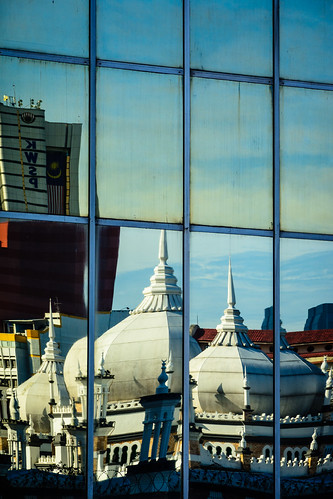 |
| The reflection of the mosque on the nearby building |
The Jamek Mosque is not the first mosque built in Kuala Lumpur. Before the construction of the Jamek Mosque, there were already two earlier mosques known to have existed in Kuala Lumpur.
One of the mosques was known as Masjid Kampung Rawa or sometimes referred to as Java Street Mosque, completed in 1881, was probably just a simple wooden building. It was seated at the corner of Java Street (later renamed Mountbatten Road and now Jalan Tun Perak) and Ampang Street (now Lebuh Ampang). The mosque was still there until as late as 1903 despite being very much in need of repair and widening. The site of the mosque is where The Gian Singh Building now stands.
 |
| The Gian Singh Building completed in 1909 stands on the site where the Kampung Rawa Mosque once stood at the corner of Java Street and Ampang Street. |
Another earlier mosque of Kuala Lumpur ever recorded is what the Indian Mosque (Masjid India) now is. The Indian Mosque that exists now originated from the Kampung Melaka Mosque said to have been built around 1859 by Encik Baki, the father-in-law of Haji Abdullah Hukom, possibly the earliest mosque in Kuala Lumpur. Over time the mosque started being patronised by Indian Muslims who migrated from India and stayed around the area. The mosque later became known variously as Masjid Keling, Masjid Chulia and Masjid India Selatan. That mosque was the precursor of the current Indian Mosque rebuilt in brick with Indo-Saracenic style in 1965.
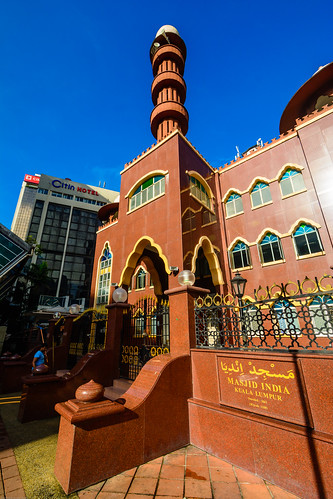 |
| The Indian Mosque originally built of timber in c. 1859 was replaced with the present 3-storey brick structure in 1965. In 2002 its walls were clad with granite slabs. |
In one of the earliest official maps of Kuala Lumpur produced in 1889 drawn by W.T. Wood, both earliest mosques of Kuala Lumpur were shown in the map. The top one in the map is the current Indian Mosque located on Dickson Street (now Jalan Masjid India) while the bottom one is the Kampung Rawa Mosque. Please also note the triangular piece of land that would be occupied by the Jamek Mosque later was labelled as the Malay Cemetery.
 |
| Two earliest known mosques in Kuala Lumpur as at 1889 |
THE CONSTRUCTION OF A NEW MOSQUE.
The triangular piece of land between the junction of the Gombak and Klang Rivers, where the Jamek Mosque is now located, was the original Muslim burial ground but by 1891 it was cleared and fenced. Prior to this it was reported that the Sanitary Board on 11 September 1890 had invited its Muslim members to select a site, on the Ampang Road, for a new cemetery which still exists until today. It is believed the old burial ground has fallen into disuse even before 1890.
Despite being cleared and fenced since 1891, only seventeen years later the triangular piece of land was chosen as the site of a larger and more impressive mosque which J.M. Gullick in his book "A history of Kuala Lumpur: 1856-1939" regarded the mosque as another example of bridging cross-cultural boundaries. For the construction of this mosque the Malay Muslims and other Muslim residents managed to subscribe $12,000 while the Selangor Government was reported to have contributed $20,000.
Having raised the required fund the design of the mosque was entrusted to the government architect, A.B. Hubback. Hubback was the prolific government architect instrumental in designing various public buildings not only in Kuala Lumpur but also in Penang, Ipoh and Seremban. The Jamek Mosque was the fifth public building in Kuala Lumpur designed by him.
The Straits Times dated 25 March 1908 reported that the foundation stone of the new Kuala Lumpur Mosque was laid, on Monday afternoon (23 March 1908), by His Highness the Sultan of Selangor, Sultan Alaeddin Sulaiman Shah (11 Sept 1863 - 31 March 1938), in the presence of a large gathering which included Mr. H.C. Belfield, British Resident, the Raja Muda and the ex-Sultan Abdullah of Perak.
The laying of the foundation stone by the Sultan of Selangor inaugurated the construction of the Jamek Mosque of Kuala Lumpur which was at that time the largest mosque in Kuala Lumpur and the first one that featured impressive design. In fact, J.M. Gullick wrote in his "A history of Kuala Lumpur 1857-1939" book that it was regarded as one of Hubback's most successful designs, modelled after Mughal mosques of north India, rather than the more ponderous 'neo-saracenic' public buildings nearby.
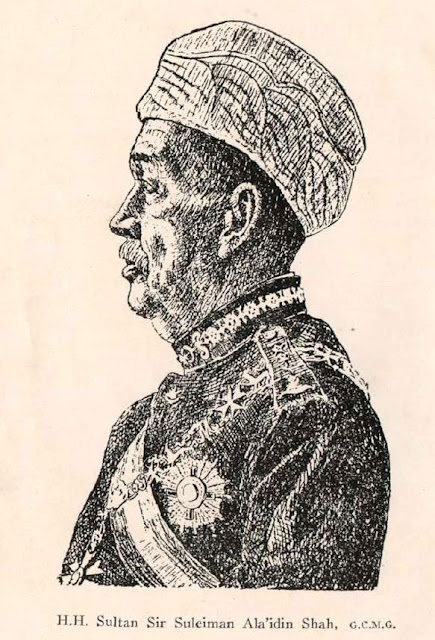 |
| His Highness the Sultan of Selangor, Sultan Sir Alaeddin Sulaiman Shah |
More than one year later, on 23 December 1909, His Highness the Sultan of Selangor, Sultan Alaeddin Sulaiman Shah, came again to Kuala Lumpur to officially open the Jamek Mosque in a grand ceremony held by the British Selangor Government. The event was also witnessed by Mr. H.C. Belfield, the British Resident of Selangor, and many other British and European dignitaries and guests besides Muslims of various communities who were mostly the inhabitants of Kuala Lumpur. The architect of the mosque, A,B. Hubback was not present though. He was reported to have been on leave back in England.
Based on a report by the Malay Mail dated 24 December 1909 the mosque had been practically completed for some time prior to the official opening ceremony on 23 December 1909. The total cost of building this mosque was approximately $37,000.00 out of which, $20,000.00 was contributed by the Selangor Government, $12,000 came from subscription by Malay and non-Malay Muslim communities and the balance was contributed by His Highness the Sultan of Selangor.
With the completion of the then new Jamek Mosque of Kuala Lumpur, it was a distinct addition to the architectural features of Kuala Lumpur. By then there was already a number of prominent public buildings completed earlier around the perimeter of the Padang (now the Merdeka square) namely the Government Offices (now the Sultan Abdul Samad Building) - completed in 1897, the Municipal Office & Town Hall - completed in 1904, the FMS Railway Service Central Office - completed in 1905 and the General Post Office - completed in 1907.
The Malay Mail dated 24 December 1909 described the design of the mosque as follows:
The Mosque, which has been built to the design of Mr. A.B. Hubback, Architectural Assistant, P.W.D., who is at present on leave at Home, is in the Arabesque style, and consists of the Mosque itself (with the mehrab facing towards Mecca), 40 ft. deep and 100 ft. wide and a courtyard in front, 56 ft. deep and 101 ft. wide. At the two corners of the courtyard furthest from the Mosque are two minarets, each 88 ft high and identical in design, with a spiral staircase leading to two circular galleries before the top one is reached.
 |
| The domes of the Jamek Mosque and the two minarets at both ends of the courtyard which make up the original structures of the Mosque. |
An arched wall encloses the courtyard on three sides, the Mosque being on the fourth, and in each of the walls there is an entrance. The inside of the courtyard is open, excepting in the centre where there is a bathing pool, and from it a flight of steps leads up to three double doors into the main building. These are the only doors, though there are windows with coloured glass the whole way around. The roof of the building opens into three domes, the centre one, which has clerestory with windows running around it, being 70 ft. in height. The materials used are brick with concrete castings and plaster, though the three domes are made of timber covered with malthoid roofing, painted white, while the floor is paved with Doulton tiles, designed after the pattern of Malay praying mat.
 |
| Restoration and renovation work in progress |
The two main minarets and other smaller ones feature the pattern of salmon-red and white banding resulting from bare brick and plastered ones which has been described as "blood and bandage". The same design was adopted on the Sultan Abdul Samad Building and the National Textile Museum.
In modern time, to cater to the growing number of worshippers, the Mosque has since been enlarged with two additional courtyards. Both courtyards, one at the north wing and the other at the south wing of the Mosque, flank the original courtyard in the middle. The original courtyard was open-air but it has since been roofed-over.
 |
| Inside the main prayer hall of the Jamek Mosque (underneath the three domes) |
One of the domes of the Mosque once collapsed in 1993 due to unusually heavy rainfall, but has since been repaired and the structure of all the domes has been strengthened.
The name "Jamek" is Arabic in origin meaning a place where people congregate to worship. The Jamek Mosque (Masjid Jamek in Malay) served as Kuala Lumpur's main mosque until the national mosque, Masjid Negara, was built in 1965.
The Jamek Mosque has been gazetted as the heritage building of Malaysia under Antiquities Act 1976 with the Gazette No. P.U. 423 on 13 October 1983.
On Friday, 23 June this year, the Sultan of Selangor, Sultan Sharafuddin Idris Shah announced the Jamek Mosque was renamed the Sultan Abdul Samad Jamek Mosque (Masjid Jamek Sultan Abdul Samad in Malay) after the mosque had been refurbished as part of the River of Life Project and it can now accommodate up to 1,000 people for prayers.
Please check out this link for more details.
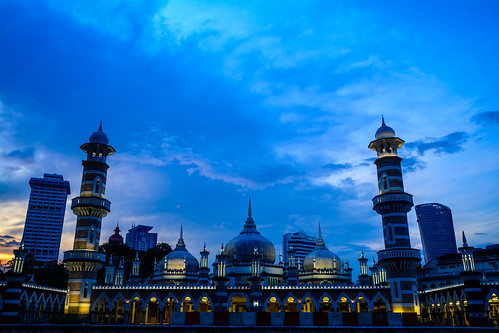 |
| The Jamek Mosque at dusk |
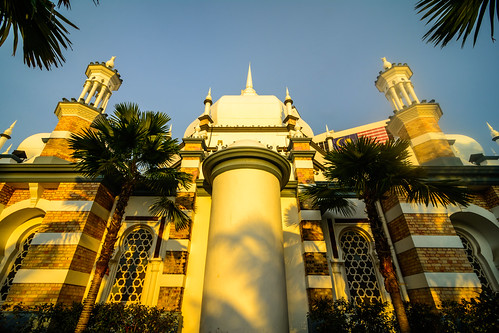 |
| The 'mihrab' - the curved protruding wall (directly under the main dome in the picture ) facing towards the direction of the Kaabah in Mecca. |
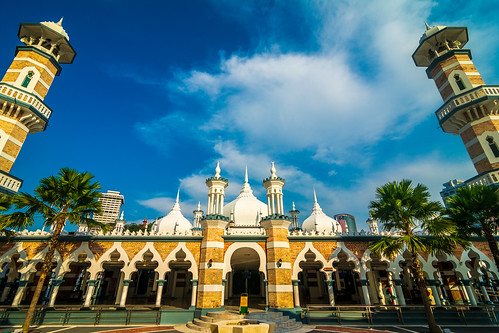 |
| The main entrance at the original structure of the courtyard. Notice the original courtyard has two minarets at the north and south corner. |
 |
| The Jamek Mosque after the completion of The River of Life Project. |
REFERENCES
Chin, K.Y., & Chen, V.F. (1998). Kuala Lumpur, a sketchbook. Singapore: Archipelago Press.
Cooper, D., & Nurzaifullah Mansor. (2007, April-June). The gazetted buildings of Kuala Lumpur. Buletin Warisan, 7-8.
Gullick, J.M. (2000). A history of Kuala Lumpur 1857-1939. Kuala Lumpur: MBRAS.
Lam, S.F. (2004). Insider's Kuala Lumpur: Is no ordinary travel guide. open your eyes to the soul of the city. Singapore: Marshall Cavendish
Mariana Isa, & Maganjeet Kaur. (2015). Kuala Lumpur street names: a guide to their meanings and histories. Singapore: Marshall Cavendish
The new mosque: Opening ceremony by the Sultan. (1909, December 24). Malay Mail.
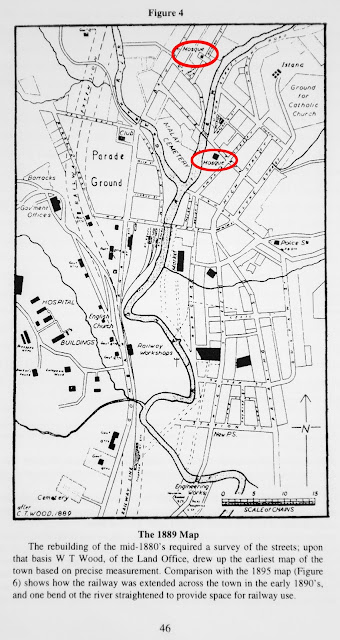


Many thanks for the brilliant write up and appreciate the lovely description of it. Glad we could have such a lovely mosque that's steeped in history.
ReplyDeleteYes. The mosque is steeped in history and it is inextricably part of the history of Kuala Lumpur itself.
DeleteThanks for dropping by.
Artikel yang menarik. Terima kasih dan selamat berpuasa tuan.
ReplyDeleteTerima kasih tuan. Saya berbesar hati jika artikel saya dpt memberi manfaat kpd sesiapa saja yg minat utk belajar.
DeleteGlad we could have such a lovely mosque that's steeped in history.
ReplyDeletethai porn
Hello i am kavin, its my first occasion to commenting anywhere, when i read this article i thought i could also make comment due
ReplyDeleteto this good piece of writing.